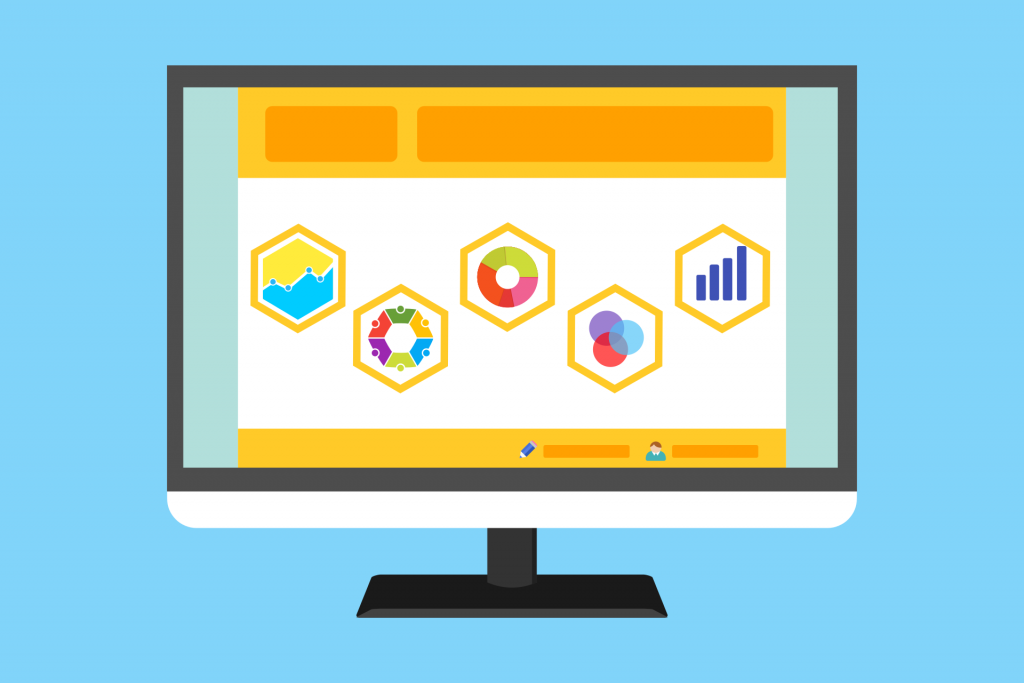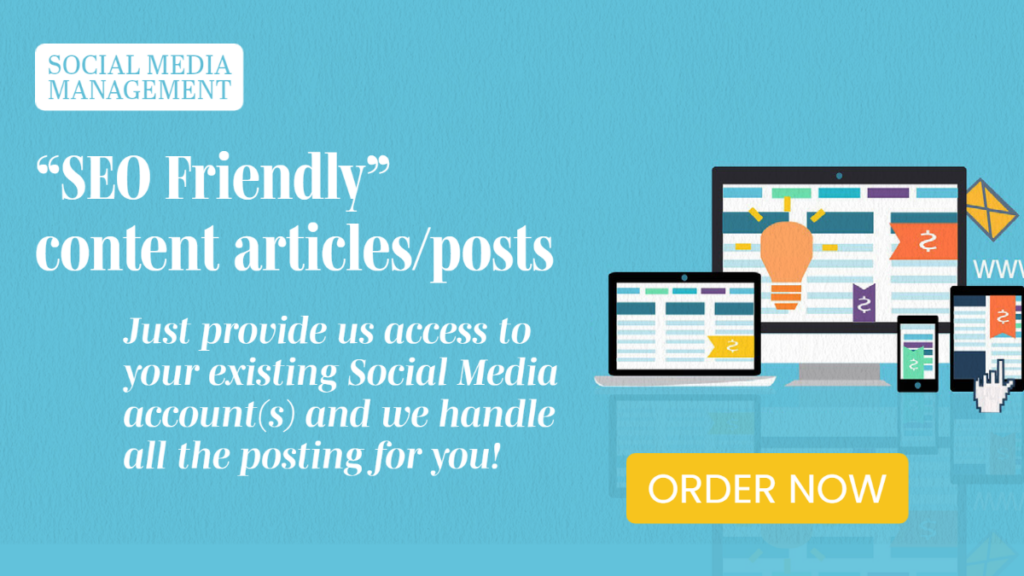Facebook and Instagram
Social Media Content Curation
Starting at $950/Month

Services Include:
- Month to Month Service
- Connect to your existing Facebook Account with our Social Media Management software platform (Facebook and Instagram. TikTok, LinkedIn, X Platforms available at additional cost/subscription) so that we can begin to schedule posts to be published monthly, allowing you time to revise your promotional schedule
- Identify and Monitor relevant #Hashtags to target your best performing organic content
- Develop one targeted content with photos (we provide stock images or graphics for 4 social media posts unless you provide images or product shots of your service) to promote your products and services targeted to your customer audience (4 posts per week scheduled between M-F)
- Monthly Performance Analysis and Reporting.
- Optional paid media posts paid advertising available for additional cost.
- Our Social Media Management services do not include customer service/comment moderation on your social platforms, that remains your purview. We can provide comment replies at an additional cost.
Social Media Management Services: Boosting Your Online Presence
Are you looking to improve your online visibility and connect with your target audience more effectively? Look no further than professional Social Media Management Services. In today’s digital age, having a strong social media presence is crucial for businesses of all sizes.
Definition and Importance of Social Media Management Services
Social Media Management Services refer to the strategies and techniques used to manage, monitor, and enhance a brand’s presence on various social media platforms like Facebook, Twitter, Instagram, LinkedIn, and more. It involves creating and sharing engaging content, interacting with followers, analyzing performance, and implementing targeted marketing campaigns.
The importance of social media management cannot be overstated. With billions of users spending a significant amount of time on social platforms, businesses need to establish a credible and engaging presence to attract potential customers, build brand awareness, and foster customer loyalty.
Benefits of Outsourcing Social Media Management
Outsourcing your social media management to professionals can offer numerous advantages. Firstly, it allows you to focus on other core aspects of your business while leaving the social media tasks in expert hands. These professionals have the knowledge and expertise to optimize your social media presence and make it work for your specific business goals. Additionally, outsourcing can save you time and energy as they handle content creation, scheduling, monitoring, and measuring the success of your social media efforts.
How Social Media Management Services Help Businesses
Effective social media management services can have a transformative impact on businesses. They help increase brand visibility, reach a larger audience, and drive targeted traffic to your website. By crafting engaging content, actively engaging with followers, and leveraging data-driven insights, professionals can help you build a loyal online community around your brand. This, in turn, can lead to increased customer loyalty, improved customer satisfaction, and ultimately, higher conversion rates and revenue.
Don’t fall behind in the competitive online landscape. Invest in top-quality social media management services to maximize your brand’s potential and boost your online presence.
Understanding Social Media Management
Social media management involves the strategic management of a brand’s social media platforms to effectively communicate with and engage its target audience. It is a crucial aspect of any successful digital marketing strategy.
A. Definition and Scope of Social Media Management
Social media management encompasses various tasks such as creating and scheduling content, monitoring and responding to audience interactions, analyzing performance metrics, and managing social media advertising campaigns. Its primary goal is to build brand awareness, increase website traffic, generate leads, and ultimately drive conversions.
B. Key Responsibilities of Social Media Managers
Social media managers are responsible for developing and implementing social media strategies, creating engaging and shareable content, managing social media communities, responding to customer inquiries and complaints, monitoring social media trends, and analyzing campaign performance. They serve as the voice of the brand on social media platforms and play a vital role in maintaining a positive online reputation.
C. Key Skills Required for Effective Social Media Management
Strategic Thinking: Social media managers must be able to think critically and develop effective strategies to achieve organizational goals.
- Creative Content Creation: They should have strong writing and design skills to create compelling and visually appealing content for social media platforms.
- Communication: Excellent verbal and written communication skills are essential to engage and interact with the audience effectively.
- Analytics: Social media managers need to have knowledge of social media analytics tools to track and analyze campaign performance and optimize strategies accordingly.
- Customer Service: They should possess exceptional customer service skills to respond to queries and complaints promptly and professionally.
- Adaptability: Social media trends and algorithms change constantly. Social media managers need to stay updated and adapt to these changes quickly.
Social Media Marketing Strategies
Effective social media marketing strategies are crucial for businesses looking to make a mark in the digital world. With the right approach, companies can maximize their social media presence and attract a larger audience. Here are some key strategies to help you succeed:
A. Importance of a Well-Defined Social Media Marketing Strategy
Having a well-defined social media marketing strategy is essential for any business aiming to navigate the complex world of social media. It provides a roadmap that outlines your objectives, target audience, content themes, and desired outcomes. By establishing clear goals and guidelines, you can better focus your efforts and make the most of your social media presence.
B. Developing an Effective Social Media Marketing Plan
An effective social media marketing plan involves careful research, planning, and execution. It starts by identifying your target audience and understanding their preferences, behaviors, and interests. With this knowledge, you can create relevant and engaging content that resonates with your followers. Additionally, defining your key messages and tone of voice will help maintain consistency and build a strong brand presence across all social media platforms.
C. Best Practices for Social Media Marketing Strategy Implementation
Implementing a social media marketing strategy successfully requires keeping up with best practices. This includes understanding the algorithms and features of each platform to optimize reach and engagement. Regularly analyzing the performance of your posts, utilizing targeted advertising, and staying up-to-date with the latest trends and technologies are all essential for staying ahead of the competition.

Content Creation and Curation
A. Crafting Engaging and Valuable Social Media Content
Creating compelling content is key to attracting and retaining your target audience on social media. It is important to understand your audience’s interests, pain points, and preferences to develop content that resonates with them. By crafting engaging and valuable social media content, you can build trust and loyalty, drive engagement, and ultimately achieve your marketing goals.
We provide social media services for your Facebook and Instagram accounts.
- Need help managing your Social Media. Our Facebook and Instagram Social Media Management will help keep your brand at Top of Mind for potential customers.
- Subscribe below and we will create and schedule 4 Social Posts Per Week on Facebook and Instagram related to your product/service. Includes Monthly Reporting on engagement and post activity.
Here are some tips for creating effective social media content:
- Know your audience: Research your target audience to understand their demographics, interests, and behaviors. This will help you tailor your content to their preferences.
- Create a content calendar: Plan your content in advance to ensure consistency and a steady stream of relevant posts. This will help you stay organized and maintain a consistent brand voice.
- Use visual elements: Incorporate eye-catching images, videos, and infographics in your posts to grab attention and increase engagement.
- Include compelling captions and headlines: Write captivating captions and headlines that entice your audience to click, share, and engage with your content.
- Provide value: Offer useful tips, advice, and insights that your audience can benefit from. This will position your brand as a trusted source of information.
- Encourage user-generated content: Engage with your audience by asking them to share their experiences, photos, or opinions related to your brand. This creates a sense of community and increases social proof.
B. Curating Relevant Content to Share with Target Audience
Curating content involves finding, organizing, and sharing valuable and relevant information from external sources with your target audience. This helps diversify your social media content and provides additional value to your followers.
Here’s how you can curate content effectively:
- Identify reputable sources: Find reputable websites, blogs, influencers, and industry experts whose content aligns with your brand values and resonates with your target audience.
- Select high-quality content: Choose content that is well-written, informative, and provides unique perspectives or insights. This ensures that you are sharing valuable information with your audience.
- Add your own commentary: When sharing curated content, add your own thoughts, opinions, or context to provide additional value and showcase your expertise.
- Give credit to the original source: Always give proper credit to the original creator of the content you share. This helps build relationships and avoid legal issues.
- Engage with the content: After sharing curated content, actively engage with your audience by asking for their thoughts, opinions, or experiences related to the topic. This encourages conversation and boosts engagement.
C. Tools and Techniques for Content Creation and Curation
Several tools and techniques can assist you in content creation and curation. These tools automate processes, provide insights, and optimize your social media management efforts.
Here are some essential tools and techniques:
- Social media scheduling tools: Use tools like Buffer, Hootsuite, or Sprout Social to schedule your posts in advance, ensuring consistent and timely content delivery.
- Content discovery tools: Utilize tools such as Feedly, BuzzSumo, or Pocket to discover relevant and trending content in your industry, helping you stay up-to-date and find valuable content to share with your audience.
- Content creation tools: Explore tools like Canva, Adobe Spark, or Piktochart to create visually appealing and engaging graphics, infographics, or videos for your social media posts.
- Analytics tools: Analyze your social media performance using platforms like Google Analytics, Facebook Insights, or Twitter Analytics. These tools provide valuable insights into your audience’s preferences, engagement levels, and content performance.
- Hashtag research tools: Optimize your hashtag usage with tools like Hashtagify, RiteTag, or Tagboard. These tools help you find popular and relevant hashtags to increase the reach and discoverability of your content.
By leveraging these tools and techniques, you can streamline your content creation and curation processes, saving time, and maximizing your social media management success.
Social Media Analytics and Reporting
A. Importance of Social Media Analytics in Assessing Performance
Effective social media management involves analyzing data and metrics to gain insights into the performance of social media campaigns. By tracking and measuring key analytics, businesses can evaluate the effectiveness of their strategies and make data-driven decisions for better results. Social media analytics play a crucial role in assessing the success of marketing efforts, identifying areas for improvement, and optimizing campaign performance.
B. Tracking Key Metrics and Data for Social Media Platforms
In order to effectively analyze performance, it is important to track and measure key metrics for different social media platforms. These metrics can include engagement rate, reach, impressions, click-through rate, conversions, follower growth, and more. By monitoring these metrics, businesses can understand their audience, identify trends, and measure the impact of their content. Tracking key data provides valuable insights that can help in refining social media strategies and improving overall performance.
C. Reporting and Presenting Social Media Insights Effectively
Once data is collected and analyzed, it is essential to present social media insights in a clear and concise manner. Effective reporting allows businesses to communicate their findings and recommendations to stakeholders. Visualizing data through charts, graphs, and reports can assist in understanding trends, patterns, and areas of success or improvement. By presenting social media insights effectively, businesses can drive meaningful discussions, allocate resources strategically, and make informed decisions to enhance their social media presence.

Community Engagement and Customer Support
Building a strong community of loyal followers is crucial for the success of your social media management efforts. Engaging with your audience and providing exceptional customer support can help nurture relationships and drive positive brand experiences. Here’s how to effectively manage community engagement and customer support on social media channels:
A. Developing Strategies to Encourage Community Engagement
To foster a vibrant community on social media, it’s essential to implement strategies that encourage active participation and interaction. Organize contests and giveaways: Creating opportunities for your audience to win prizes or gain exclusive access to your products/services encourages them to engage with your brand.
Pose thought-provoking questions: Engage your followers by asking questions that spark discussions related to your industry, products, or services. This not only encourages participation but also helps you gain valuable insights.
Share user-generated content: Encourage your audience to create and share content related to your brand. Reposting and showcasing user-generated content can significantly boost engagement and make your followers feel appreciated.
B. Effective Customer Support on Social Media Channels
Providing exceptional customer support through social media channels is essential for maintaining a positive brand image. Respond promptly: Timely responses to customer queries or complaints demonstrate that you value their concerns and are committed to resolving them.
Personalize your responses: Address customers by their name and tailor your responses to their specific questions or issues. This personal touch helps create a positive customer experience and strengthens the bond with your brand.
Offer proactive support: Monitor your social media channels for any customer issues or complaints, even if they haven’t directly tagged or mentioned your brand. By proactively addressing such concerns, you show your commitment to customer satisfaction.
C. Managing Online Conversations and Resolving Customer Issues
Social media platforms provide a space for customers to voice their opinions, both positive and negative, about your brand. It’s crucial to manage online conversations effectively and resolve any customer issues promptly. Monitor mentions and comments: Stay vigilant and respond to any mentions or comments related to your brand, whether they are positive or negative.
Handle negative feedback with care: When addressing negative feedback, it’s important to remain calm and empathetic. Apologize for any inconvenience caused and work towards finding a solution that satisfies the customer.
Take conversations offline if necessary: If a customer issue requires further discussion or private information, encourage them to reach out to you via direct messages or email to resolve the matter privately.
By effectively engaging with your community and providing exceptional customer support on social media, you can cultivate a positive brand image, build loyalty, and drive customer satisfaction.
Social Media Advertising and Promotion
Social media advertising is a powerful tool that allows businesses to reach their target audience efficiently and effectively. With the right strategies and techniques, you can create ad campaigns that generate significant returns on investment.
Leveraging Social Media Advertising to Reach Target Audiences
Social media platforms offer a wide range of targeting options, allowing you to reach specific demographics, interests, and behaviors. By leveraging these features, you can ensure that your ads are seen by the right people.
- Segmentation: Segment your target audience based on factors such as age, gender, location, and interests to create personalized ad campaigns.
- Custom Audiences: Upload customer lists or use pixel tracking to retarget existing customers and engage with them on social media.
- Lookalike Audiences: Find new potential customers who share similar characteristics with your existing customer base.
Creating Effective Ads and Promotional Campaigns
Creating compelling and visually appealing ads is crucial to capture users’ attention and drive them to take actions. Here are some tips to help you create effective ad campaigns:
- Clear Messaging: Ensure your ad’s message is concise, clear, and aligns with your overall marketing goals.
- Engaging Visuals: Use high-quality images or videos that resonate with your target audience and reflect your brand identity.
- Call-to-Action: Include a clear call-to-action that prompts users to take the desired action, such as visiting your website or making a purchase.
- A/B Testing: Experiment with different ad variations to identify the most effective elements and optimize your campaigns.

Analyzing Ad Performance and Optimizing Campaigns
Regularly monitoring and analyzing your ad performance is essential to optimize your campaigns and achieve the best possible results. Consider the following factors when analyzing and optimizing your social media advertising campaigns:
- Click-Through Rate (CTR): Measure the percentage of users who click on your ads to determine their effectiveness and relevance.
- Conversion Rate: Analyze the number of users who complete a desired action after clicking on your ads, such as making a purchase or filling out a form.
- Cost-Per-Click (CPC): Evaluate the cost-effectiveness of your ads by calculating the average cost per click.
- Ad Placement: Test different ad placements and optimize based on performance to maximize visibility and engagement.
By continuously analyzing and optimizing your social media advertising campaigns, you can improve your return on investment and achieve your marketing objectives.
Social Media Listening and Monitoring
Social media listening and monitoring play a crucial role in the success of any social media management strategy. By actively monitoring and tracking conversations happening online, businesses can gain valuable insights and take actionable steps to enhance their presence.
Importance of Social Media Listening for Business Insights
Social media listening allows businesses to understand what people are saying about their brand, products, or industry. By tracking relevant keywords and phrases, businesses can uncover valuable insights about customer preferences, needs, and pain points. This information can then be used to inform marketing strategies, product development, and customer service initiatives.
In addition to customer insights, social media listening also allows businesses to keep a close eye on their competitors. By monitoring competitor activities and customer conversations about them, businesses can identify areas where they can improve and gain a competitive advantage.
Tools and Techniques for Social Media Listening and Monitoring
There are various tools and techniques available to help businesses effectively listen and monitor social media conversations. These tools range from free options such as Google Alerts and social media platform analytics to more advanced paid options like Brandwatch and Sprout Social.
When it comes to techniques, businesses can set up searches and alerts using specific keywords related to their brand, industry, and competitors. These searches can be performed on social media platforms, blogs, forums, and news websites.
Analyzing Conversations and Sentiments for Actionable Insights
Once the social media conversations are tracked, it is crucial to analyze the data and sentiments to extract meaningful insights. Sentiment analysis tools can help in determining whether the conversations are positive, negative, or neutral. This analysis enables businesses to identify trends, patterns, and areas that require immediate attention.
By analyzing conversations and sentiments, businesses can identify potential crises, reputation management opportunities, and areas where they can engage with their audience effectively. This data-driven approach ensures that businesses can make informed decisions and take appropriate actions to improve their social media performance.
Influencer Marketing and Collaborations
In today’s digital landscape, influencer marketing has become an essential strategy for businesses looking to expand their reach and connect with their target audience. By collaborating with influencers, brands can leverage their popularity and credibility to promote their products or services effectively. Here’s how influencer marketing can benefit your social media management services:
A. Understanding Influencer Marketing and its Benefits
- Boosting Brand Awareness: Influencers have a dedicated follower base, and their endorsements can help expose your brand to a wider audience, increasing brand visibility and recognition.
- Building Trust and Credibility: By partnering with influencers that align with your brand values, you can leverage their trust and credibility to enhance your brand’s reputation and establish a positive image.
- Driving Engagement and Conversions: Influencers can create content that resonates with their followers, resulting in higher engagement rates and ultimately driving conversions for your business.
B. Identifying and Engaging with Influencers in Targeted Niche
When implementing influencer marketing, it’s crucial to identify influencers that are relevant to your niche and target audience. Here are some strategies to help you find and engage with the right influencers:
- Research and Analysis: Utilize social media listening tools and platforms to identify influencers who are influential within your industry and have an engaged following.
- Establish Authentic Connections: Engage with influencers by commenting, sharing their content, and building meaningful relationships before reaching out for collaboration opportunities.
- Personalized Outreach: When approaching influencers, tailor your communication to showcase how their collaboration can mutually benefit both parties while highlighting why your brand is a good fit for their audience.
C. Influencer Collaboration Strategies for Maximum Impact
To maximize the impact of influencer collaborations, consider implementing the following strategies:
- Content Co-creation: Work with influencers to create compelling content that is not only promotional but also provides value to their audience, enhancing authenticity and engagement.
- Giveaways and Contests: Collaborate with influencers to host giveaways or contests, encouraging audience participation and generating buzz around your brand.
- Affiliate Marketing: Implement affiliate programs to track conversions and provide influencers with incentives to promote your products or services.
Social Media Platform Management (Facebook, Twitter, Instagram, etc.)
Managing social media platforms like Facebook, Twitter, Instagram, and others requires a deep understanding of each platform’s unique features and best practices. Effective management of these platforms can significantly enhance your brand’s online presence and engagement.
Using Facebook for social media management allows you to connect with a wide range of audiences. You can create and share different types of content, such as images, videos, and articles, to engage your followers. It’s important to monitor comments, respond to messages, and maintain an active presence to foster a strong Facebook community.
Twitter, on the other hand, is known for its fast-paced nature. With its character limit, crafting concise and catchy tweets is key to capturing your audience’s attention. Utilizing hashtags and engaging with trending topics can help increase your visibility. Building a strong Twitter presence requires regular posting and active engagement with your followers.
Instagram is a highly visual platform where aesthetics and storytelling play vital roles. It’s an ideal platform for sharing captivating images and videos that represent your brand’s image. Utilizing features like stories, reels, and IGTV can expand your reach and engage with your audience. Building an Instagram community involves consistent posting, fostering meaningful connections, and leveraging relevant hashtags.
Other social media platforms like LinkedIn, Pinterest, and Snapchat also offer unique opportunities for brand management. Understanding the best practices and tailoring content strategies for each platform is crucial in maximizing your brand’s impact across multiple channels.
Social Media Scheduling and Automation Tools
Managing social media accounts can be time-consuming and overwhelming, especially if you’re juggling multiple platforms. That’s where social media scheduling and automation tools come to the rescue. These tools can help you streamline your social media activities, save time, and improve your overall efficiency.
A. Utilizing Social Media Scheduling Tools for Efficient Management
Social media scheduling tools allow you to plan and schedule your posts in advance. Instead of manually posting content throughout the day, you can create a content calendar and schedule your posts to be automatically published at specific times. This eliminates the need for constant monitoring and manual posting.
- Social Scheduler: This powerful tool allows you to schedule and publish posts across multiple social media platforms. It offers advanced features such as bulk scheduling, content recycling, and analytics to help you optimize your posting strategy.
- Hootsuite: Hootsuite is a popular social media management platform that enables you to schedule posts, monitor conversations, and manage multiple accounts in one place. It supports various social media networks, including Facebook, Twitter, Instagram, LinkedIn, and more.
- Buffer: Buffer is another great option for scheduling and publishing social media posts. It provides a user-friendly interface, content suggestions, and analytics to help you enhance your social media strategy.

B. Automation Techniques to Streamline Social Media Activities
In addition to scheduling tools, automation techniques can further streamline your social media activities. By automating repetitive tasks, you can focus more on engaging with your audience and creating valuable content.
- IFTTT (If This Then That): IFTTT is a web-based service that allows you to create custom automation rules, known as applets. With IFTTT, you can automate various actions across different platforms. For example, you can automatically share your Instagram posts on Twitter or schedule a Facebook post whenever a new blog is published on your website.
- Zapier: Similar to IFTTT, Zapier is a powerful automation platform that connects different apps and triggers actions based on predefined conditions. It offers a wide range of integrations to automate tasks and workflows, saving you time and effort.
C. Evaluating and Selecting the Right Tools for Business Needs
Choosing the right social media scheduling and automation tools for your business is crucial. Consider the features, pricing, user-friendliness, and compatibility with the platforms you use. It’s also essential to read reviews and compare different options to ensure the chosen tools align with your specific business needs.
Stay organized and efficient with social media scheduling and automation tools. They’ll help you maintain a consistent presence, engage with your audience, and ultimately drive better results for your social media management efforts.


